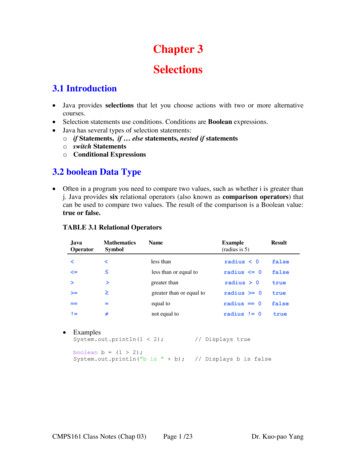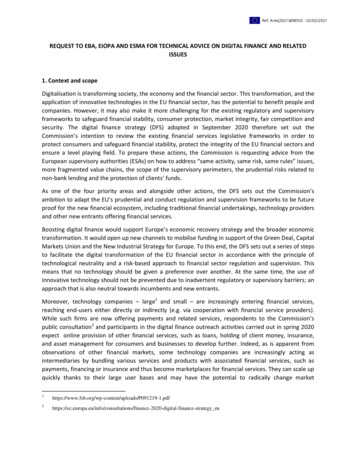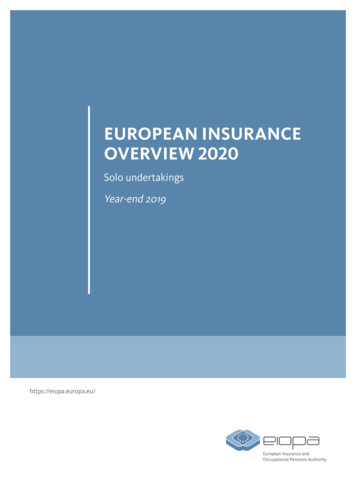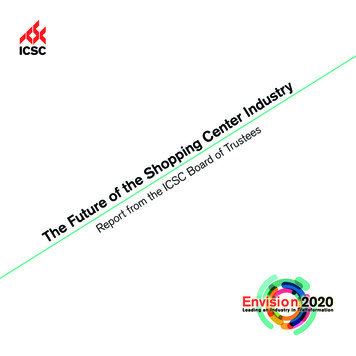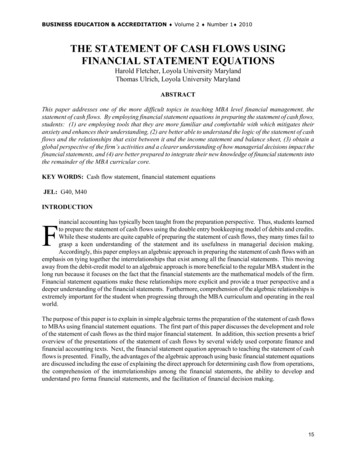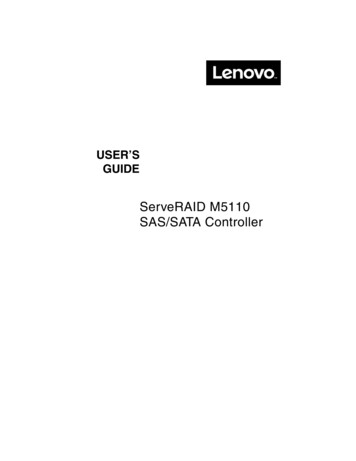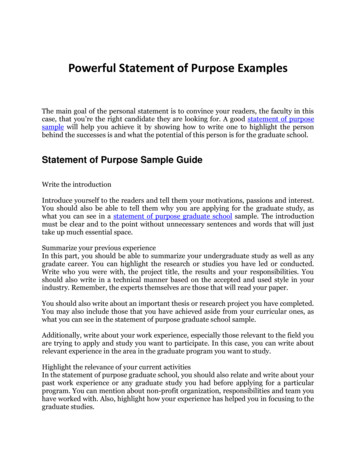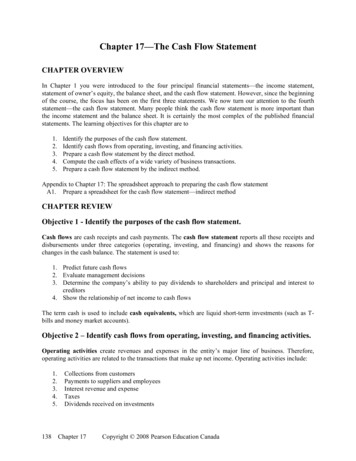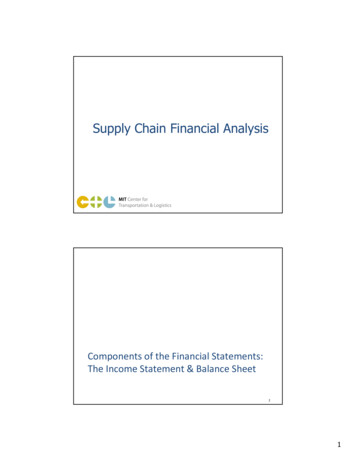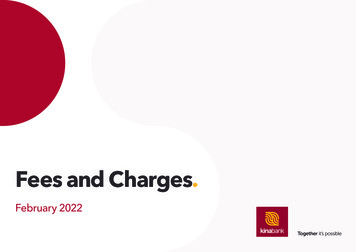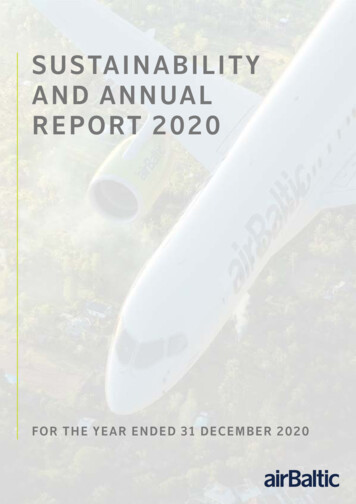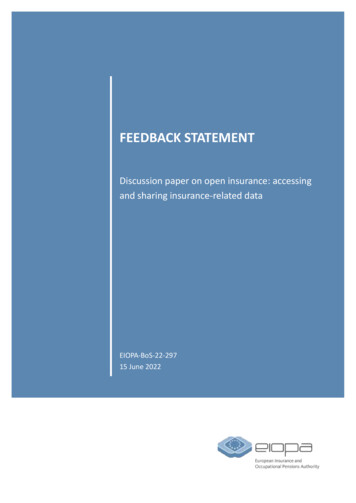
Transcription
FEEDBACK STATEMENTDiscussion paper on open insurance: accessingand sharing insurance-related dataEIOPA-BoS-22-29715 June 2022
FEEDBACK STATEMENT – DISCUSSION PAPER ON OPEN INSURANCEINTRODUCTIONArticle 1(6) of the Regulation establishing the European Insurance and Occupational PensionAuthority (EIOPA) (Regulation (EU) No 1094/2010) requires EIOPA to contribute to promoting asound, effective and consistent level of regulation and supervision, ensuring the integrity,transparency, efficiency and orderly functioning of financial markets, preventing regulatoryarbitrage and promoting equal competition. In addition, Article 9(2) requires EIOPA to monitor newand existing financial activities. The above is a key motivation underpinning EIOPAs work ondigitalisation.On 28 January 2021 EIOPA published a discussion paper and launched a public consultation on“open insurance: accessing and sharing insurance-related data”, in order to better understand openinsurance developments and risks and benefits related to that.In the report, EIOPA explored whether and to what extent insurance value chains should be‘opened’ up by the sharing of insurance-related and specific policyholder data amongst insuranceand non-insurance firms, with a view to protect policyholder rights and to allow for innovation inproducts and services.EIOPA concluded there might be potential on open insurance for consumers, for the sector and itssupervision, if handled right. A key consideration on possible open insurance solutions is how tofind a balance between data protection, insurance, and competition regulations while supportinginnovation, efficiency, consumer protection and financial stability.EIOPA received 65 replies from consumer associations, industry, national and European industryassociations, technology providers and academia.Page 2/20
FEEDBACK STATEMENT – DISCUSSION PAPER ON OPEN INSURANCEFigure 1 Type of respondentAcademia5%Technologycompany7%Insurance %Source: EIOPA public consultation on open insurance: accessing and sharing insurance-related dataA high-level summary of the responses received can be found in this feedback statement, withpossible EIOPA next steps. The full list of all the non-confidential comments provided can be foundon the EIOPA public website.EIOPA will consider the feedback in its on-going and future work on digitalisation, subject toprioritisation, EIOPA's work programme and EIOPA Digital Transformation Strategy.EIOPA would like to thank all the participants to the public consultation for their comments on theDiscussion Paper.Page 3/20
FEEDBACK STATEMENT – DISCUSSION PAPER ON OPEN INSURANCE1. DETAILED OVERVIEW OF THE RESPONSES1.1. DEFINITION AND APPROACH TO OPEN INSURANCEThe Discussion Paper stated there is no uniform definition of open insurance or open finance. Asthe phenomenon is new and carries both risks and benefits for consumers, National CompetentAuthorities (NCAs) and for the industry, EIOPA considered open insurance in its work so far in thebroadest sense, covering accessing and sharing insurance-related personal and non-personal datausually via Application Programming Interfaces (APIs).Respondents were asked if they agree with the definition and approach of open insurance. Out ofall respondents, 57% agreed with the definition and approach highlighted in the discussion paper,while 33% disagreed. Many stakeholders shared the view that open insurance should be defined inthe broadest sense. On the other hand, many of the stakeholders (mostly industry associations) feltthe definition is too broad.Figure 2 Open insurance definitionDo you agree with the definition and the approach to open insurance highlighted in theDiscussion Paper?I don t know5%n/a5%YesNo33%NoYes57%I don t known/aSource: EIOPA public consultation on open insurance: accessing and sharing insurance-related dataAmong relevant issues, stakeholders reported concerns regarding consumer consent, noting thedefinition should include more procedural aspects concerning personal data and non-personal data,Page 4/20
FEEDBACK STATEMENT – DISCUSSION PAPER ON OPEN INSURANCEand regarding General Data Protection Regulation1 (GDPR) compliance. Many stakeholders referredto the need of some level of standardisation and harmonisation.Finally, it was mentioned that it is important not only to consider insurance-related data, but alsorisk-related data, hence the use cases and general language (such as “consumer”) should bereviewed so the definition would include also business insurance angles. A different stance wasexpressed by other stakeholders that suggested a more customer-centred framework.1.2. OPEN INSURANCE USE CASESMore than half of the respondents reported additional open insurance use cases to those describedin the report. They include: better risk assessment and mapping; preventive measures; fraud detection and prevention; databases to share information to increase efficiency and leveraging data to provide semiautomated advice.Respondents also mentioned APIs providing access to customers’ personal insurance data (data oninsurable assets and coverage), and the use of Open Banking data for insurance purposes. Healthdata exchange, insurance-as-a-service and platformisation solutions, including personalisedproduct offerings in third-party ecosystems, digitalisation and data sharing in the commercialinsurance space, sharing of consumer complaints data and API solutions and standardised interfacesin the insurance intermediaries market were also mentioned. Stakeholders also noted that someuse cases could improve pricing practice and transparency (e.g. help to avoid “loyalty penalties”).Another cluster was related to blockchain/DLT solutions based on open insurance data.Stakeholders mentioned the possibility of a decentralised market for insurance products, e.g.blockchain-based contract administration, allowing peer-to-peer insurance. Holistic personalfinancial management platforms and pension dashboards for mapping active coverages andidentifying gaps were also mentioned. Potential use cases in mobility sector were also highlighted.This includes third-party data collectors and providers, such as autonomous cars and robotics andoffering of road-side assistance. Stakeholders also saw the potential in sustainable finance and inshared resilience solutions.Regulation (EU) 2016/679 of the European Parliament and of the Council of 27 April 2016 on theprotection of natural persons with regard to the processing of personal data and on the free movement ofsuch data, and repealing Directive 95/46/EC (General Data Protection Regulation) (OJ L 119, 4.5.2016, p. 1).1Page 5/20
FEEDBACK STATEMENT – DISCUSSION PAPER ON OPEN INSURANCEStakeholders mentioned that open insurance could also improve RegTech/SupTech solutions. Areference was made to machine-readable regulation and supervisory guidelines. The potential fortools for the collection and analysis of Key Information Document (KID) were also mentioned.Stakeholders also mentioned real-time collection by supervisors of data through APIs directly frominsurers and intermediaries but also from IoT providers (e.g. health IoT data and connected cardata). In this way supervisors could identify poor advice or conduct other automatic compliancecontrols. Some noted more generally that open insurance could improve data sharing with NCAs.1.3. PUBLIC COMPARISON WEBSITESStakeholders were also asked if regulators/supervisors should put more focus on public comparisonwebsites where the participation is compulsory for insurance undertakings. Opinions were quitesplit for this question, with 31% of respondents answering “yes” and 44% answering “no”.The most common benefits mentioned by multiple stakeholders were enhanced consumerprotection, more transparency and easier overview of alternative insurance offers, increasedcompetition as well as facilitation of switching providers. Some stakeholders noted this coulddecrease price discrimination of vulnerable consumers, and help smaller or unknown providers into gain market share.However, many obstacles were also noted, starting with a lack of standardisation and comparabilityof insurance products. It was noted that majority of insurance products aren’t comparable betweenMember States due to differences in jurisdictions, structure of social services, tax systems, customerpreferences, market practices etc. Local insurance solutions have been tailored to the market needsover decades, and so harmonisation through compulsory public comparison websites may be oflimited value.Some stakeholders also noted the need for a specific framework on compulsory public comparisonwebsites and for more transparency on how the actual comparison works. Additionally, there is aneed for regulation or monitoring of private comparison sites in case they serve as a first contactpoint for customers and have their own B2C business. Another obstacle would also be ensuring thequality and accuracy of data. Some respondents believed there should be a differentiation betweencompulsory websites for consumers and brokers, and that regulators/supervisors should havebetter access to data for supervisory purposes.Some stated that it could be complex and costly to establish appropriate APIs. Compulsoryparticipation may also add non-risk-driven costs to products, increasing the premiums for theconsumer. Stakeholders also saw challenges with balancing costs and benefits so thatimplementation costs are not ultimately borne by customers. Other comments included questionsPage 6/20
FEEDBACK STATEMENT – DISCUSSION PAPER ON OPEN INSURANCEof liability and the fact that advice cannot be fully replaced by transparent and standardisedprocessing of information.One stakeholder noted that insurance products aim at long-lasting relationships and the ability tochange products on a regular basis may lead to loss of value as additional fees may be incurred.Many respondents indicated a concern that a public comparison website would generate a race tothe bottom, leading to underinsurance, as consumers navigate by price instead of a combination ofprice and coverage. Similarly, there is a risk of excessive standardisation, leading towards productuniformity, as well as a risk of undermining competition and hindering innovation. Furthermore,respondents observed that customers may not be aware of the restricted scope of privatecomparison websites not showing a full market representation.1.4. OPEN INSURANCE RISKS AND BENEFITSStakeholders were asked if they agree the potential benefits and risks are accurately described forconsumers, for the industry and for supervisors. A significant majority of the respondents agreedwith the description of the potential benefits. Without further clarification, some stakeholders,however, have disagreed with the benefits presented by EIOPA.Figure 3 Open insurance benefitsDo you agree the potential benefits are accurately described?05101520253035Strongly disagreeSomewhat disagreeNeither agree nor disagreeSomewhat agreeStrongly agreeConsumersIndustrySupervisorsSource: EIOPA public consultation on open insurance: accessing and sharing insurance-related dataMany respondents highlighted as benefits: increased transparency and efficiency; better tailored products taking into account consumer demands and needs; better understanding of the risks;Page 7/20
FEEDBACK STATEMENT – DISCUSSION PAPER ON OPEN INSURANCE lower costs and increased digitalisation, automation and innovation, including “real time”insights.One stakeholder noted that more accurate and granular data could lead to more resilience in theindustry. Some mentioned under benefits that open insurance would potentially allow for increasedadaption of pricing to the willingness-to-pay as well as monetisation of existing customer basewithin ecosystems. Another stakeholder noted the potential of embedding insurance into servicesin a way which makes the insurance "invisible" to the consumer (e.g. warranty). Some noted it couldstreamline the way in which standard risks are assessed and facilitate seamless digital managementof multi-country insurance policies. Some noted open insurance could increase financial inclusion.The majority of respondents also agreed with the description of the risks.Figure 4 Open insurance risksDo you agree the potential risks are accurately described?05101520253035Strongly disagreeSomewhat disagreeNeither agree nor disagreeSomewhat agreeStrongly agreeConsumersIndustrySupervisorsSource: EIOPA public consultation on open insurance: accessing and sharing insurance-related dataMany stakeholders expressed concerns on: the security and misuse of data; the risks of exclusion (either due to the data or to technological illiteracy); discrimination or exploitation of natural persons; data could be used to shape and influence the forming of political opinions were alsomentioned.Also, many stakeholders expressed concern that consumers may be oversharing or not be fullyaware of the data they are sharing, and there were worries regarding consent more generally. Onerespondent mentioned the risk of discrimination against consumers who choose not to share theirdata. Some also expressed concerns regarding the increased cost and complexity of regulatorycompliance and the risk of distorting competition, while there may also be a lack of innovation andPage 8/20
FEEDBACK STATEMENT – DISCUSSION PAPER ON OPEN INSURANCEinvestment. The risk of supervisory arbitrage in case of no proper cooperation between NCA wasalso mentioned. Finally it was pointed out that open insurance could weaken the mutualisationprinciple.1.5. BARRIERS, CHALLENGES AND CURRENT REGULATORYFRAMEWORKStakeholders were asked if they considered the current regulatory and supervisory framework asadequate to capture potential risks and if not, what can be done to mitigate these risks. Additionallystakeholders were asked about potential barriers in EU insurance and non-insurance regulation. Thissections highlight different views from stakeholders. However, EIOPA stresses that, while some ofthose concerns are universal, others relate to the possible path taken on open insurance (i.e.voluntary / market-led approach or some degree of regulatory steer or compulsory data sharing).More than half (52%) of the respondents believe that the current framework is not adequate tocapture the risks, while only 18% believe that it is. Most stakeholders highlighted the importance ofthe principle of level playing field, “same activity, same risks, same rules”, supervisory convergence,the need for adequate supervisory resources (e.g. staff, budget, technical expertise) as well as riskbased and proportional approach to supervision. Following that, some stakeholders noted thatthere should be safeguards for free and informed consumer consent, in order to mitigate the risks,while some also mentioned that a uniform regulation would be beneficial. Similarly, somerespondents referred to the need for a regulation for data exchange and data reciprocity and robustdata governance framework. Some respondents referred to competition issues as a considerableconcern, even if not in the scope of insurance supervision. The reluctance of the market to disclosedata on voluntary basis was also highlighted.Some stakeholders stressed the importance of raising awareness on open insurance as well as ofcollaboration with the industry, stating that this would help to address the risks and barriers.Similarly, it was noted that upcoming legislative proposals such as DORA, Digital Markets and DigitalServices Act and others will help in facilitating the development of a framework for Open Insuranceand mitigate some of the risks. The potential of national innovation facilitators was also stressed bysome.One stakeholder stated that screen scraping technology should be prohibited. Another highlightedthe importance of higher penalties to slow down the spread or prevent the misuse of data.Stakeholders were also asked if they agree on barriers highlighted in the report. Only 4 (8%) of therespondents somewhat disagreed with the barriers highlighted in the EIOPA Paper, while nonestrongly disagreed. Most stakeholders (50%) somewhat agreed while some (20%) strongly agreed.Page 9/20
FEEDBACK STATEMENT – DISCUSSION PAPER ON OPEN INSURANCEFigure 5 Open insurance barriersDo you agree with the barriers highlighted in chapter 5?20%0% 8%22%50%Strongly disagreeSomewhat disagreeNeither agree nor disagreeSomewhat agreeStrongly agreeSource: EIOPA public consultation on open insurance: accessing and sharing insurance-related dataMany of the respondents stressed the importance of ensuring that regulation would not impedeeffective open insurance initiatives based on voluntary agreements, but rather enable them. Somestakeholders also elaborated on the need of clarifying the relationship of open insurance initiativewith data protection rules (GDPR), as well as the need for a more harmonized regulatory andtechnical basis within the European Union so to avoid legal uncertainty.Some stakeholders highlighted the importance of interlinkages with sectors outside ofinsurance/finance. It was questioned how large technology companies will be regulated whenpersonal data exchange happens outside insurance sector i.e. between insurers/intermediaries andtechnology companies. Some stakeholders have mentioned lack of harmonisation and issuesrelated to cross-border data sharing as well as the aggregation and anonymity of data.Some stakeholders noted that more awareness is needed regarding registration under the IDD andhighlighted that some stakeholders do not know they are required to be registered. Regardingcurrent requirements on the scope of (re)insurance activities, it was noted that Article 18(1)(a) ofthe Solvency II Directive states that Member States shall require every undertaking for whichauthorisation is sought in regard to insurance undertakings, to limit their objects to the business ofinsurance and operations arising directly therefrom, to the exclusion of all other commercialbusiness. Stakeholders highlighted that this provision is interpreted differently across memberstates and can act as a barrier.Finally, one respondent believed that better access to public sector data should be prioritized.1.6. LESSONS LEARNED FROM OPEN BANKINGPage 10/20
FEEDBACK STATEMENT – DISCUSSION PAPER ON OPEN INSURANCEStakeholders were asked what are the key differences between banking and insurance industry toconsider in light of open insurance implementation and what lessons learned could be used fromopen banking/PSD2.There appeared to be consensus among the respondents that regulators should learn from PSD2,but not copy it. A common concern is that insurance products/contracts are much less standardisedthan in banking, while also being significantly more sensitive and varied. Some respondents alsomentioned that the frequency of banking transaction is much higher. Some stakeholders noted thatPSD2 Account Information Service and Payment Initiation Service would be difficult and slow toreplicate in insurance.Additional differences mentioned by the stakeholders are that insurance often assumes a longerterm view than banking services and it is related more to risk assessment/prevention than only tofinancial aspects. Depending on the line of business, the frequency of consumer contact is lower inthe insurance sector. Some stakeholders noted that open insurance would involve more crossborder activities than banking.One stakeholder noted that PSD2 is sectoral directive, rather than an industry-wide one. Anotherpointed out a distinction between B2B and B2C insurance.Multiple stakeholders mentioned that clear standards and regulations are needed, and that a levelplaying field needs to be ensured: if the insurance industry shares their data, then third partiesshould also share their data. Furthermore, the risks and difficulties of taking open insurance intopractice should be taken into account, together with the importance of independent local entitiesto identify implementation risks.Stakeholders also highlighted that open insurance could require significant investments intoinfrastructure and compliance and that technical difficulties should not be underestimated. Insurersshould also prepare themselves for industry disruption. Some stakeholders highlighted the need toproperly communicate the potential benefits clearly to the end users and to educate consumers.Similarly, it was highlighted that a clear definition of the roles of different players involved in openinsurance is necessary.1.7. POSSIBLE REGULATORY INTERVENTIONRegulatory vs non-regulatory interventionStakeholders were first asked if open insurance would develop without any regulatory intervention(e.g. without PSD2 type of compulsory data sharing provisions). Views varied here and more than athird (39%) believe that open insurance will develop without regulatory intervention, while 30%Page 11/20
FEEDBACK STATEMENT – DISCUSSION PAPER ON OPEN INSURANCEbelieve it will not.2 Some respondents, and in particular insurance associations, feel that amarket/industry-lead open insurance platform might be beneficial.The reason in favour of open insurance developing without regulatory intervention is that insurersare already exchanging data between parties through APIs. However, stakeholders believed thatstandardisation and harmonisation are still necessary.On the other hand some respondents also noted that it may be more difficult and more costly foropen insurance to develop without regulatory intervention, while many also pointed out that thisdevelopment would be much slower and the necessary consumer protection needs may not be met.Regulatory intervention vs market-led approachStakeholders were also asked if open insurance should be driven voluntarily by industry/privateinitiatives or driven by regulatory intervention.Almost half (49%) of all respondents chose a mix of the two options. The rest of the non-blankresponses were almost evenly split, with 18% of the respondents choosing private initiatives and17% regulation. Looking at the types of respondents who chose these options, it can be seen thatconsumer associations chose a regulatory approach, while most industry associations chose privateinitiatives or a mix of the options. Most insurance and reinsurance undertakings, as well as allacademia, chose a mix of the options, and none of the technology companies chose privateinitiatives.The main argument presented in favour of regulation is the minimisation of risks for consumers.Additional benefits mentioned include the reduction of costs from running parallel systems, the factthat consumers would be more willing to share their data in regulatory-driven system, and thatincumbents would not act unless it is compulsory to share data. One of the stakeholders in favourof a regulatory approach considers that regulation should define minimum requirements, buttechnical aspects should be left for the industry to solve.The arguments presented in favour of private initiatives are that they could already be in place, andthat regulation should not undermine existing or incoming private open insurance initiatives.Furthermore, industry players would be able to decide whether data sharing can yield benefits andhow.Most stakeholders in favour of a mix of the approaches mention a granular approach which shouldguarantee compliance with existing legislation. Some believe that participation should be voluntaryinitially, and afterwards driven by regulation. Others favour an approach where regulators andsupervisors should facilitate the development of open insurance, while private initiatives create awill in stakeholders to improve. It was also referred that sandboxes could play a central role of open2The rest either abstained from responding or responded “I don’t know” (16%).Page 12/20
FEEDBACK STATEMENT – DISCUSSION PAPER ON OPEN INSURANCEinsurance developments. One stakeholder believes that it is premature to decide on an approachand that the purpose of open insurance should be clearly defined first.Finally, stakeholders were also asked on their views on how the EU insurance market may developif some but not all firms (e.g. based on different industry-wide initiatives) open up their data to thirdparties.Stakeholders often mentioned that the market would become fragmented and the strongestinsurers might not participate in voluntary data sharing. Other views were that adopters may forman oligopoly, cutting off non-adopters and thus hampering competition, as well as increasing therisk of cartels between dominant companies. Furthermore, if only some companies adopt openinsurance, the data may be skewed or not representative of the population, resulting in inadequateproducts, while there may also be some disparity and un-level playing field due to unequal accessto data and information.Some noted that in absence of a uniform, foreseeable framework, it is likely that the EU insurancemarket will be less innovative and less consumer-centric, as putting trust in industry-wide initiativesfor data sharing will lead to less competition and less consumer centric-offerings.Some respondents also foresee benefits of this approach, such as lower costs of open insurance dueto a lack of scale, or the fact that the split between ‘open’ and ‘closed’ insurance could allowsupervisors to compare the approaches. A stakeholder also noted that the market may not changemuch in the middle term, while another believes that the EU insurance undertakings may becomedata managers also for third parties in the ecosystem, that they could support third parties throughadvanced analytics.Preferred regulatory/licensing approachEIOPA presented in its paper different open insurance approaches from regulatory/supervisoryperspectives. Compulsory data sharing inside the regulated insurance industry was the leadingresponse with 18 selections, followed closely, with 17 mentions each, by the same with third partieswith bespoke licensing approach, and a mix of the approaches. Following that, 13 of thestakeholders chose a self-regulatory approach to data sharing. With the least votes (3-5),respondents have chosen compulsory data sharing covering only IoT data/sensor data or only incertain lines of business and/or amongst certain products, or the “other” option. Industryassociations mostly propose a self-regulatory approach or a mix of the approaches (see above).Some of the respondents have included additional comments concerning their selection. Theyreported that the issue is difficult to assess, and that the customer should have the final word.Moreover, stakeholders believe that revisions to the current framework are needed, while somewould prefer self-regulation until sound regulation is in force to allow for compulsory data sharing.Some also stated that mandatory data sharing should only be required in areas in which competitionPage 13/20
FEEDBACK STATEMENT – DISCUSSION PAPER ON OPEN INSURANCEis hindered by data monopolisation of dominant market participants. Some also stated that nocompulsory data sharing should be introduced but instead development of technical standards fordata sharing could be considered. Some stakeholders noted that a self-regulatory approach by itselfcould lean towards a lack of standards in the data, which would in turn undermine the integrity andcomparability of the data. Finally some stakeholders noted that patchwork of interlinked initiativeson data should be avoided.1.8. DATA SETS IN OPEN INSURANCE FRAMEWORKStakeholders were also asked about datasets that should be definitely included or excluded in thescope of a potential open insurance framework.Many of the respondents accept that basic consumer data and product information should beincluded while noting the need to be compliant with the GDPR. Some highlighted that only databeneficial to customers, industry and supervisors should be included, others stated that should beincluded financial data and non-financial data strictly necessary to facilitate the provision of theinsurance service. Some stakeholders also mentioned public information as well as sustainabilityand environmental related data including geospatial and weather, data on cyber incidents reportedto public authorities, frauds, medical records directly from medical institutions, mobility and IoTdata including on connected vehicles, and information useful for the KYC process.From the consumer perspective, some stakeholders stated that all data the consumer would wantto share should be included. Others asked to include data that allows customers an appropriatemanagement of their insurance: e.g. cancellation data, policy renewal, time of payment of thepremium, validity of the policy etc. or fraud detection/fraud information, excluding all pricing or riskfactors. Others stated more broadly that data that builds up the single customer insurance policysituation should be included. Reference was also made to product information, including thedescription of coverage and generic company information. Data relating to registeredproperty/goods was also mentioned.The stakeholders agreed that anything consumers do not give consent for sharing should beexcluded from any open insurance framework. Specific examples mentioned were data about healthand medical conditions, sexuality, political views, claims data or risk model data, tariffs, compliance,supervisory reports, or insurers’ proprietary information whose sharing could damage competition.Some noted that data prohibited from being shared by authorities, behavioural data that may allowto gain insights into policy and pricing strategy, and any data related to children should be excluded.One stakeholder believed that the types of data to be excluded depend on the specific use case.Another expressed that no data should be excl
financial management platforms and pension dashboards for mapping active coverages and identifying gaps were also mentioned. Potential use cases in mobility sector were also highlighted. This includes third-party data collectors and providers, such as autonomous cars and robotics and offering of road-side assistance. Stakeholders also saw the potential in sustainable finance and in shared .
